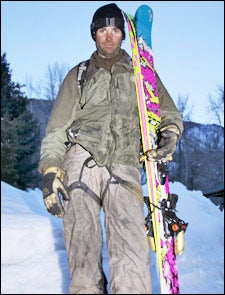1. If I’m on a glacier, I need really dark shades. The Julbo Micropores [$120; ], with Alti Arc X8 lenses, are the darkest I could find, and they have side hoods to keep out other reflected light. The more coverage, the better.
Chris Figenshau
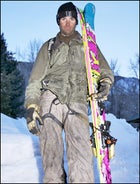 Chris Figenshau on assignemnt in the burned forests of Sun Valley, Idaho. See more at
Chris Figenshau on assignemnt in the burned forests of Sun Valley, Idaho. See more at 2. Black Diamond‘s Whippet Self-Arrest [$90; ] is a pole with an ice ax on top. It’s for those times when you’re walking on hard snow and you realize that if you fell, you wouldn’t have anything to stop you. It’s kind of nice to have that extra security.
3. I always have extra junk on my back, and I’m performing a lot of high-angle kick-turning getting to places, so my skis need to be really light and easy to maneuver. The K2 Seths [renamed Obsethed; $825; ] are perfect┬Śforgiving and really good on climbs.
4. I’m a Nikon guy. I manually focus most of my shots, and Nikon lenses are easier for that, in my opinion. I shoot with D3 and D200 camera bodies [$5,000, $1,400; ]. I also used to stash a point-and-shoot Canon [] in my pocket for easy access┬Śuntil I smashed it rock-climbing.
5. For mountaineering packs, my five-year-old The North Face Prophet 65 [since redesigned; $299; ] is one of my all-time faves. It has very little structure, so you can remove the suspension and smash it into a bigger bag. It carries well even when it’s not full and has foldout padding on the back, which enables it to become a half-size bivy sack.
What Andrew McLean, Ski Mountaineer, Brings
McLean, 47, is one of the world's most accomplished backcountry skiers, with first descents on every continent—and more than 100 total. This spring, he's off to Greenland for a few more. Here's what he's packing.
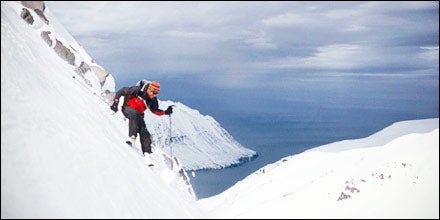
1. A trash-compactor bag is good for emergencies and on expeditions. It can be used as a poncho, a shelter, or a place to stash a sleeping bag to keep it dry. If you get a black one, you can fill it with snow and tie the top off, and later that day the snow will be melted.
2. Digging someone out of an avalanche with a flimsy shovel was a huge eye-opener. I use a G3 Avitech [$74; ]. It has a good-size metal blade, high sides, and a flat back for making good snow pits. The shaft is machined, not all jangly and loose, and its handle is D-shaped, for more power or to clip to your pack.
3. On occasion, I’ll take cheeseburgers on day trips. They kind of hit the spot. They travel really well and are totally indestructible. You’re out there and everyone’s macking down on granola and sprouts and stuff, and you pull out your Big Mac. People are like “That’s disgusting. Let me try some.”
4. I bring two-way radios on expeditions or on photo shoots. If you’re going fast, you get separated, and it’s good to use them just for communicating. Because they tend to get lost, I kind of like the cheapos, like the Motorola SX600R [$40; ].
5. I did a beacon review for Skiing Magazine, and the Pieps DSP avalanche transceiver [$450; ] was way ahead of everything else. It does a good job on multiple burials; you can lock in on one signal. It has the best range┬Śnearly 70 meters┬Śand it’s intuitive and fast.
What Eric Larsen, Polar Explorer, Brings
He's skied to the North Pole and mushed across the Canadian Arctic, and in 2009 Larsen, 37, will try to be first to reach both poles and the summit of Mount Everest in one year. Here's some of the gear he usually has in tow.
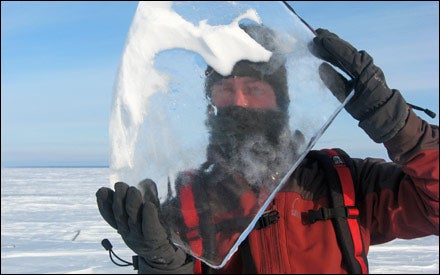
1. A tunnel tent [we recommend the Hilleberg Nammajt 2, $545; ] is the easiest kind to set up while wearing mittens in 30-below temps and extreme wind. I anchor one end with an ice screw or snow stake and then let the wind blow it up. I’ve done it in as little as a minute and a half.
2. I’m always bending something back into place or adjusting my bindings, so my Leatherman Juice S2 [$60; ] is indispensable. It has pliers, scissors, a Phillips, a flathead, and a knife┬Śall of which are critical┬Śand weighs just 4.4 ounces.
3. I take a Canon PowerShot G9 [$500; ] that I keep close to my body to preserve the battery. It’s manual and automatic, has 12.1 mega┬şpixels, and takes RAW-format pictures, so it basically has all the benefits of an SLR but in a smaller, lighter point-and-shoot.
4. I charge my iPod and satellite phone in a couple of hours with Brunton’s SolarRoll 14 [$437; ]. It works even in whiteouts. It’s also durable and very light, a little thicker than the paperboard of a cereal box.
5. I live in sunscreen. I’ll use two: a sport cream like Reflect [4 oz, $5; ], with an SPF of 30, and zinc oxide doubled up on my nose and ears. I put it on thick and leave it white. I like the smell. It’s great to be sitting in the Arctic and having a really vivid image of the beach in your head.
What Victoria Jealouse, Snowboarder, Brings
Jealouse has been called snowboarding's most influential female rider. This fall, when she appears in Teton Gravity Research's Under the Influence, her 22nd film, she'll probably be carrying some of the following.
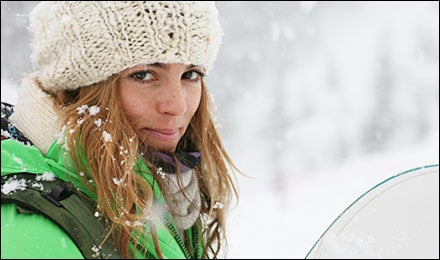
1. Everyone is always stoked to have a sip of hot tea or soup after a long day. I use an old, discontinued Outdoor Research thermos [we recommend Sigg‘s one-liter Thermo Basic Line, $35; ]. Cheap thermoses don’t work in the cold at all; I’ve tried many kinds. Get the most expensive one you can find and you’ll get many hours of extra heat each day.
2. I like shea-butter lip balm because it doubles as sunscreen and is made from natural ingredients, instead of metals and chemicals. Karite Lips, by Mode de Vie [$8; ], is my favorite. The main sunscreen I use is Organic Lavender SPF 30, by Alba Botanica [4 oz, $10; ]. It’s water-resistant, works the best, and smells good.
3. I always have a first-aid and repair kit I assembled myself. I use a small toiletries bag and put in scissors, tape, gauze, and a few bandages. I also wind duct tape around a pen to make a small spool. Plastic zip ties are super-strong and can be used in case something breaks. In isolated places, I also carry a small, flexible splint.
4. My satellite phone paid for itself the very first time I used it to call for help. It seems expensive, but it’s cheap life insurance. The one I use is by Qualcomm, and my subscription is with Globalstar. But I’m thinking about switching to Iridium [we recommend the Iridium 9505A, $1,000; ], which has more and newer satellites.
5. I bring a Freshette [$24; ], a little ergonomic funnel that you can pee into by just unzipping your fly. It has saved my ass from frostbite many times. You can even write your name in the snow.




